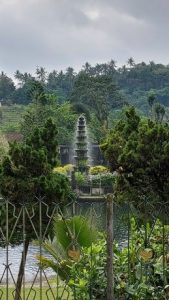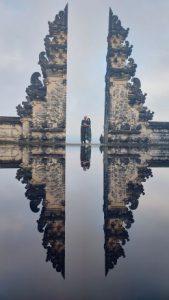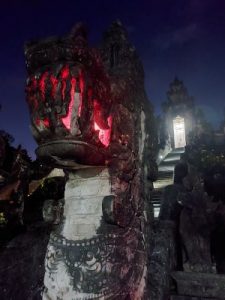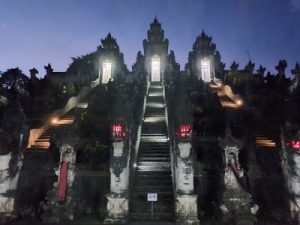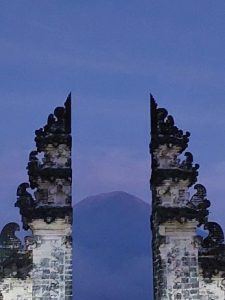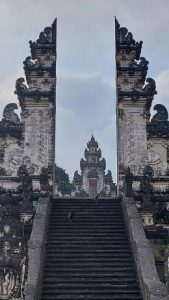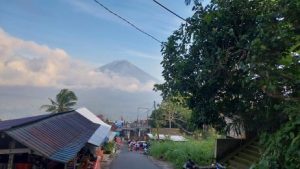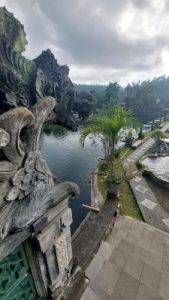
Another holiday dispatch from Bali…
After the atmospheric, scenic but heavily tourist-orientated experience of Bali’s Lempuyang Temple, it was a relief to visit Tirta Gangga Royal Water Garden (or Water Palace, depending on which travel book or website you read) in the same area. You weren’t shepherded around, you didn’t have to queue, the be-all and end-all of the place wasn’t to have some cute pictures of yourself taken that you could slather over your social media pages. Although, inevitably, there were some folk at the Water Garden obsessed with taking cute pictures of themselves.
Rather, this was a place where you could wander freely and immerse yourself in the gorgeous surroundings – whilst keeping a sensible distance from the selfie-fanatics. Also, for a morbid creature like myself, there were some unexpectedly dark things lurking in a back corner of the site, which I found fascinating. More on those later.
The antiquity of the garden’s appearance hides the fact that it’s a relatively recent construction. It was designed and built by the King of Karangsem in the late 1940s. (So enthusiastic was the King about the project that he literally built it, for he was one of the labourers digging out its pools and ponds.) However, despite its modernity, it already has a history of being razed and ruined. In 1963, the nearby volcano Mount Agung, the scenic backdrop for the countless photographs being taken at Lempuyang Temple, erupted and destroyed it, and it had to be rebuilt.
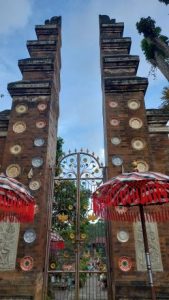
After passing through the entrance, which contained a tall, narrow candi–bentar-style gateway with different-coloured, florally-patterned ceramic plates embedded in its brickwork like lines of giant buttons, we descended into the garden. Across to the left was South Pond, a large, rectangular body of water with a long, thin island stretched across its middle, almost dividing it in two. The island had the dramatic name of Demon Island, although rather than demons the only things on it were a row of fountains. The bridges attaching Demon Island to the ‘mainland’ at either end were decorated with dragon-cum-sea-serpent creatures with scaly, rippling bodies.
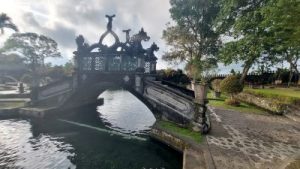
The garden’s main attraction, however, was to the right of the entrance steps and paths. This was the smaller but more ornate Mahabharata Pond, whose attractions were threefold. First, its waters were full of grey and pink carp, some of them truly big and torpedo-like. People were buying bread and throwing chunks of it at the carp, causing much tumultuous splashing as they surged up to feed. Secondly, the pond’s surface was dotted with statues, maybe four or five-feet tall, depicting sitting or crouching figures in elaborate Balinese headgear. They were slightly dilapidated, in a picturesque way. Their white surfaces were partly discoloured and scabbed with flaking grey or brown lichen. Little fern-like plants sprouted from their bases just above the waterline. Their faces occasionally had so many blotches they resembled Harlequin masks.
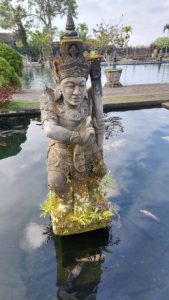
And thirdly, running along the pond’s surface and threading between the statues were lines of stepping stones. Really, these were the tops of octagonal stone pillars standing on the pond’s bed, which poked a couple of inches above the water. Needless to say, the stepping stones were a big draw for the photo-obsessed visitors and lots of people were posing for pictures on them. Sometimes couples tried to pose together on the same stone and looked in serious danger of tipping over into the pond. I assumed the carp weren’t carnivorous.
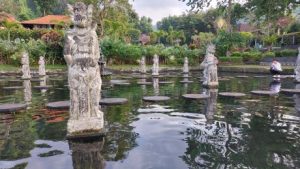
The garden’s other features included a handful of further ponds and pools, an amphitheatre and an auditorium. But the most impressive item was Nawa Sanga Fountain, which stood at the far end of Mahabharata Pond and resembled a tall, slim, eight-tiered pagoda. Seen from a distance, the water weeping past the edges of its tiers enclosed it in a shimmering halo. Green, mouldy growths had gathered on the eternally-wet segments between the tiers, but somehow the mould didn’t diminish its elegance.
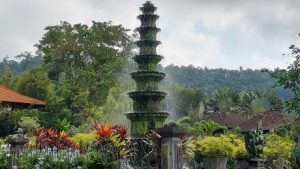
Oddly, the accounts of Tirta Gangga Royal Water Garden I’ve read online have all failed to mention something I discovered at the far right-hand corner of the premises. This was a compound that had at its centre a ring of seven statues, presumably representing Balinese and / or Hindu deities. Four of the seven, endowed with physical attributes typical of deities in this part of the world, such as having four arms, or having three faces, or having unfeasibly big hands, looked fairly innocuous. Their faces were serene, their heads topped with Balinese crowns or tiaras. But the other three statues were, frankly, monstrous.
In the notes I made at the time, I described one as having ‘…splayed, scalpel-ended fingers… a skirt of long, dangling things, like headless snakes… a mouth gaping horribly, a tongue pouring out of it… goggling eyes, long, matted hair’ and looking ‘…like a marauding zombie.’ Another, I wrote, was ‘…less monstrous…’ but ‘…still alarming… like a particularly rabid vampire…’ with ‘…a gaping mouth, snaking tongue…’ and ‘…long, scratchy fingers.’ Its hands were like ‘…clusters of carrots, Nosferatu-style.’
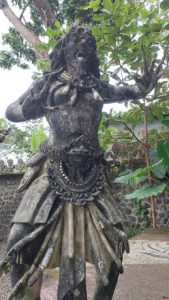
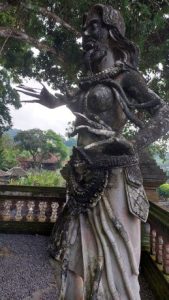
The third statue was ‘…a truly ghastly thing…’ with ‘…fingers so long and sharp its hands resembled tree-roots.’ It was ‘…seemingly neckless and shoulder-less, its head a mound of horribleness piled on top of its torso.’ The head had ‘…a mane of long, worm-like things…’ that I wasn’t sure were supposed to be ‘…weird, sprouting growths or just tresses of (very manky) hair.’ Its mouth contained ‘…a big row of upper teeth…’ and a ‘…protruding tongue bifurcating and bifurcating again until it resembled a cluster of starfish.’ This shambling creature would have given H.P. Lovecraft sleepless nights.
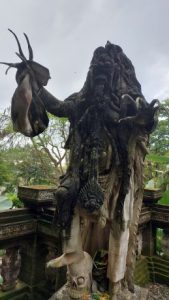
On the site’s map, I think the compound was described as a ‘meditation centre’. I would have found it difficult to meditate there in the presence of three of its residents.
And that was my unexpectedly-creepy last port of call in the grounds of the otherwise beguiling and decorous Tirta Gangga Garden Royal Water Garden.
